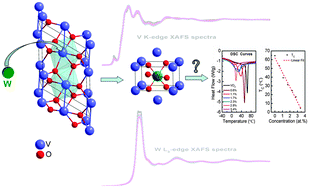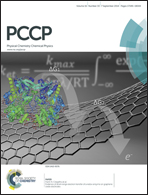Depressed transition temperature of WxV1−xO2: mechanistic insights from the X-ray absorption fine structure (XAFS) spectroscopy†
Abstract
The mechanism for the decreasing critical temperature (TC) of the metal–insulator transition (MIT) in vanadium dioxide (VO2) by tungsten (W) doping is a matter of debate. Here, to clarify the correlation between W doping and TC, the electronic and geometrical structures around W and V atoms in WxV1−xO2 samples are systematically investigated by X-ray absorption fine structure (XAFS) spectroscopy. The evidence of electron doping of W6+ ions in VO2 is obtained from the reduction of V4+ to V3+ ions. This kind of electron doping has been considered to favor the MIT process. Moreover, from the XAFS results, the local rutile structure around W dopants is identified even at low doping, and acts as the structure-guided domain to facilitate the MIT in VO2. Considering the electronic band structures of WxV1−xO2 samples, the internal stresses induced by W6+ doping yield the detwisting of the nearby monoclinic VO2 lattice. This lattice detwisting will drive the downward shift of the π* electron band and a smaller separation between antibonding and bonding d∥ orbitals in the band structure of VO2, which induces the decreased band gaps of WxV1−xO2 samples. As a consequence, the potential energy barrier for phase transition is lowered and the reduced TC is observed.


 Please wait while we load your content...
Please wait while we load your content...